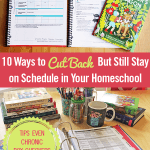
When I started homeschooling my daughter, I read a small excerpt in the Instructor’s Guide (IG) of my curriculum about how to track progress. The recommendation was to place a checkmark after each completed activity. Adding the date was optional. If homeschooling multiple children, it was suggested that the child's initials be used instead of checkmarks.
This plan worked really well until life started to serve up various other learning opportunities that deserved our attention:
- a total eclipse of the sun
- a local gem and mineral show
- a new baby
Suddenly, getting everything done and checking it off in the IG became cumbersome instead of helpful. For sanity’s sake, I still wanted to follow the schedule, but to allow for more freedom and avoid overload, we really needed to cut back. I needed to figure out how to follow the schedule without feeling like we needed to complete every listed activity.
Here are 10 ways we have successfully cut back on activities while still using Sonlight's IG.
Continue reading below or listen here:
1. Skip What They Already Know
There are a couple of different ways to revise the schedule in the IG to better accommodate what your child already knows. First, slash through the boxes that you don’t need to complete.
When the total eclipse came through East TN in 2017, I used the weekly subject list in my Science IG to find all the resources related to this phenomenon. We read through the chapters, safely viewed the eclipse, and my children gained a fabulous understanding of the sun and moon. When those topics came up in the schedule, I simply checked them off as completed and moved forward.
Alternatively, pull out your highlighter and mark all the activities that will add value to your homeschool. Only highlight items that your child needs to complete. If there’s time and desire, you can always pick a few more activities.
For Language Arts, the glossary of phonics rules and skills check-off list make it possible to quickly identify the areas in which your child needs the most work and highlight them in the schedule.
2. Save Something For Rainy Days
When you skip an activity that doesn't have to be done at the table, write it on an index card. When you have a rainy day or need a few things to pass the time, pull out your index cards. Once you complete an activity, go back and record it in the IG. Including the IG page number on the card can help with organization.
3. Reduce “School Time” Activities
Read-Alouds, Readers, and Bible study are parts of our day done outside of what we call “homeschool” hours. We read Bible as part of our morning routine. Read-Alouds and Readers get slotted for bedtime or during downtimes throughout the day.
4. Enjoy the Flow
If your kids are really into a topic, don’t be afraid to keep going. You’ll be amazed at how much you’ll accomplish. My kids got incredibly excited about chickens, and we finished two weeks worth of study in a day and a half. Don’t worry too much about the other subjects; they’ll still be there. When the kids are passionate about what they’re learning, capitalize on it!
5. Incorporate Block or Loop Scheduling
We have had success blocking off our Wednesdays as Science days. Although we may read Science on other days, we do the bulk of our experiments on Wednesdays. The kids know to expect this, and it the habit keeps me organized.
We do most of our extracurricular activities on a loop (rotating) schedule. Art, music, and mindfulness are currently on our loop schedule. Whenever we have the time for extracurriculars, we simply move onto whichever subject is next to make sure we cover a little of everything.
6. Slow Down
You don’t have to cover every subject every day. Consider switching to a four-day school week. Maybe go to a year round homeschool with more frequent breaks. Look for ways to reduce the tedium that can come with too much routine work. It’s perfectly OK to take longer than a school year to complete a program. In fact, that kind of pacing is one of the major advantages of homeschooling. If you’ve entered a rough period, consider deschooling or taking a complete break to decompress. School goes so much easier when you have a willing and interested learner.
7. Simplify Activities
There are several activities that can be simplified or shortened. For instance, worksheets for science can easily be talked through as opposed to completed with pencil. Consider using the Read-Aloud discussion questions only to spot check comprehension, but don’t feel they all have to be answered if your child seems to be understanding the material.
8. Consider Time-based Activities
Instead of completing an assigned number of pages, consider setting a timer. One of my kids loves the motivation of a countdown and routinely does more than the recommended number of pages. My other child finds the timer itself stressful, but responds well when I say, “You’ve got 30 more minutes to read before lunch.”
9. Eliminate Duplicates
If you are participating in co-op classes or attending events outside the home that cover material in your curriculum, use the curriculum resources only as a reference. Sometimes repetition can be helpful, but don’t do activities merely to mark off checkboxes. The appendix of your Sonlight Instructor's Guide provides a schedule of topics and skills covered by subject for easy reference.
10. Save Some Activities as Review
Some of the activities in your IG can easily be used as review. For example, map work and the timeline figures used in The Timeline Book make a fabulous history and geography review. Once we complete our history studies within a particular scope or region (easily determined by the scope and sequence appendix in the IG), we cut out and color our timeline figures and add them to The Timeline Book. Then we add markers to our wall maps to reflect the areas and people we have studied.
Regardless of what tactics you may choose to keep pace with your curriculum's IG, at some point there are likely to be at least a few activities that you will have to make peace with letting go. When this happens, try to remember that even in our best public and private schools, it is unusual for a teacher to be able to complete an entire textbook or course of study in one year. As homeschoolers, we have a huge advantage in being able to tailor the curriculum to our children’s individual needs.
Simplify your homeschool and reduce the burden of daily decision making. Switch to Sonlight. Start by requesting a free catalog here.











4 Comments